Deneb, Alpha Cygni (α Cyg), is a class A supergiant located at an approximate distance of 2,615 light years from Earth. With an average apparent magnitude of 1.25, it is the brightest star in the constellation Cygnus and the 19th brightest star in the sky. The supergiant is the most distant and most luminous first magnitude star. It is part of two prominent seasonal asterisms, the Summer Triangle and the Northern Cross.
Star type
Deneb is a blue-white supergiant of the spectral type A2 Ia. It has 19 times the Sun’s mass and a radius of around 203 solar radii. With an estimated surface temperature of 8,525 K, it is 196,000 times more luminous than the Sun. The supergiant has a projected rotational velocity of about 20 km/s.
Deneb has stopped fusing hydrogen at its core, but its next stage of evolution is difficult to predict. It is currently either cooling and expanding to become an exceptionally luminous red supergiant or it is on its way to becoming a luminous blue variable (LBV), possibly even a Wolf-Rayet star. Either way, Deneb’s mass indicates that the supergiant will end its life as a supernova within the next few million years.
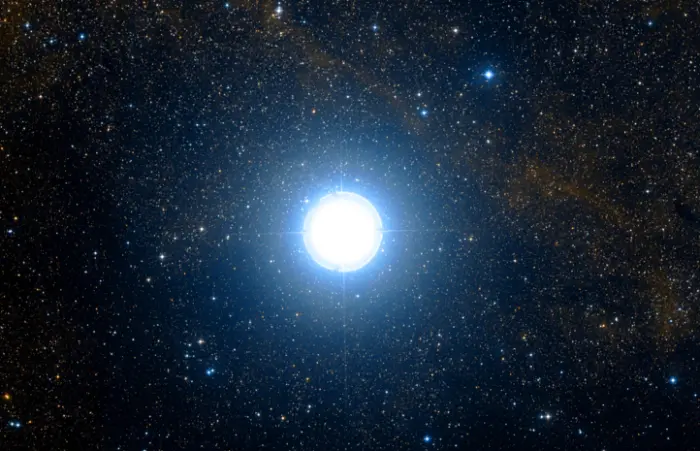
Deneb (Alpha Cygni), image created using the Aladin Sky Atlas software from the Strasbourg Astronomical Data Center and DSS (Digitized Sky Survey) data. DSS is one of the programs of STScI (Space Telescope Science Institute) whose files are in the public domain, credit: Roberto Mura (CC BY-SA 4.0)
Distance
The distance of Deneb has been measured using a number of different methods which produced different values. Hipparcos satellite measurements of Deneb’s parallax in the early 1990s yielded a value of 1.01 ± 0.57 milliarcseconds, which was consistent with the distance of about 2,615 light-years or 802 parsecs.
However, later analyses of the Hipparcos data have given a considerably larger parallax and significantly smaller distance. A 2009 study that analysed the Hipparcos data placed the star much closer, at 1,550 light-years (475 parsecs) away, with a 15% margin of error.
The star’s exact distance is still uncertain and has a significant margin of error.
Size
Deneb’s luminosity and temperature, as well as its small angular diameter of 0.002 arcseconds yield a radius about 203 times that of the Sun. This makes Deneb one of the largest A-type stars known. If it replaced the Sun in the centre of our solar system, the supergiant would engulf Mercury and Venus and extend all the way to the Earth’s orbit.
In comparison, two other bright A-type supergiants, Aspidiske (Iota Carinae) in the southern constellation Carina and Eta Leonis in Leo, have radii 43 and 47 times that of the Sun, respectively. They are both much smaller and less luminous than Deneb, with energy outputs of 4,900 and 19,000 solar luminosities.
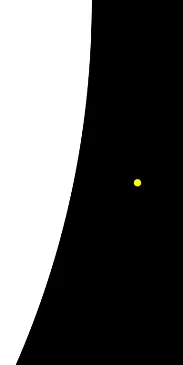
Deneb – Sun comparison, image: Wikimedia Commons/Uwe Dedering (PD)
Mass
Deneb has a mass of 19 solar masses, with a margin of error of 4 solar masses. Before evolving into a supergiant, it was a blue O-type main sequence star with a mass of about 23 solar masses.
Like all exceptionally massive stars, Deneb burned through its supply of hydrogen fuel quickly and evolved away from the main sequence within only millions of years. The supergiant loses about a millionth of a solar mass each year (or one Earth mass per 500 years) through powerful stellar winds.
Stars in Deneb’s mass range typically evolve into luminous red supergiants before ending their lives in core collapse supernovae. More massive stars expel their outer layers and become hotter. They may evolve into yellow hypergiants, luminous blue variables or Wolf-Rayet stars before going out as supernovae.
Luminosity
Deneb is one of the most luminous stars visible to the unaided eye. The blue-white supergiant is the most luminous first magnitude star, with an estimated luminosity of up to 196,000 times that of the Sun and an absolute magnitude of -8.38. If it were placed at Vega‘s distance, Deneb would be bright enough to cast shadows on Earth. The star’s intrinsic luminosity makes it one of the visually brightest stars known.
However, even though different instruments and methods have been used to measure the supergiant star’s properties, these are still mostly uncertain, and some luminosity estimates are as low as 40,000 and 55,000 times solar.
Brightness
With an average visual magnitude of 1.25, Deneb is the brightest star in the constellation Cygnus and the 19th brightest star in the sky. It is only slightly fainter than Pollux in the constellation Gemini and Fomalhaut in Piscis Austrinus, and it just outshines Mimosa in Crux and Regulus in Leo.
Deneb is a variable star. Its brightness has been observed to vary between magnitude 1.21 and 1.29. The star’s brightness fluctuates rapidly due to pulsations with multiple periods, ranging between 6.9 and 100.8 days. A 2019 study also found a longer period of about 800 days.
Similar small-scale rapid fluctuations have been observed in many early supergiants. These stars were officially grouped into a class, the Alpha Cygni (ACYG) variables, in 1985 in the fourth edition of the General Catalogue of Variable Stars.
Similar variability has also been observed in many luminous blue variables during their hot phases, but these stars are normally classified as LBVs, not as Alpha Cygni stars.
Alpha Cygni variables
Deneb is a prototype for a class of variable stars known as the Alpha Cygni variables. These stars are class B or A supergiants that exhibit changes in brightness on the order of 0.1 magnitudes.
Their brightness varies as a result of non-radial pulsations, meaning that some parts of their stellar surface are contracting while others simultaneously expand. The pulsations can appear irregular because there are multiple pulsation periods, which typically last from several days to several weeks.
Notable Alpha Cygni variables include Rigel (Beta Orionis, mag. 0.05 – 0.18), Alnilam (Epsilon Orionis, mag. 1.64 – 1.74), Aludra (Eta Canis Majoris, mag. 2.38 – 2.48), Kappa Cassiopeiae (mag. 4.12 – 4.21), Rho Leonis (mag. 3.83 – 3.90), and CS Camelopardalis (mag. 4.19 – 4.23).
The nature of the non-radial fluctuations in these stars is not fully understood, and their cause is uncertain, in part because they are not restricted to a specific range of luminosities and surface temperatures like most other pulsating stars.
Deneb’s variability has been known since the early 20th century. The star’s variable radial velocity was first reported by O. J. Lee, an astronomer at Yerkes Observatory, University of Chicago, who published his findings in The Astrophysical Journal in March 1910.
Facts
Deneb is part of two large asterisms that dominate the evening sky during the northern hemisphere summer, the Summer Triangle and the Northern Cross.
The Northern Cross is a constellation-based asterism formed by the brightest stars of Cygnus. Deneb marks the top of the cross, Aljanah (Epsilon Cygni), Sadr (Gamma Cygni) and Fawaris (Delta Cygni) outline the crossbeam, and Albireo (Beta Cygni) appears at the base. These five stars form the body of the celestial Swan in the constellation figure of Cygnus. Deneb marks the tail, Sadr the chest, Aljanah and Fawaris the wings, and Albireo the beak.
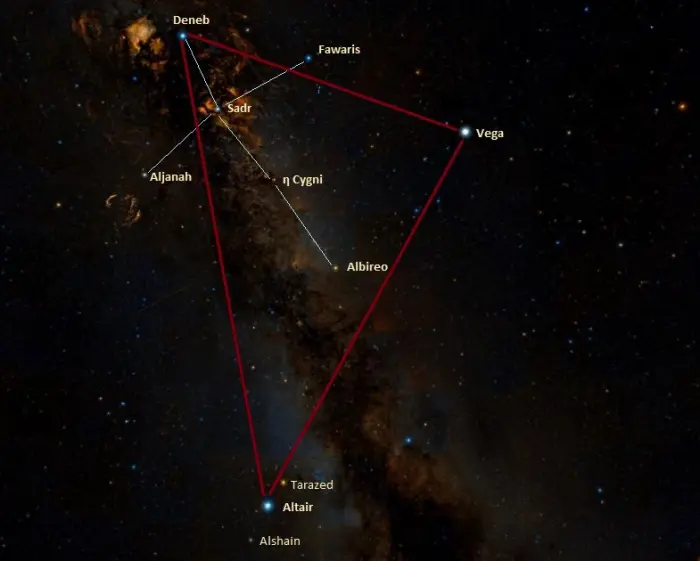
The Summer Triangle and the Northern Cross, image: Wikisky
Most of the Northern Cross appears within the larger Summer Triangle, one of the most familiar star patterns in the summer sky in the northern hemisphere. The Summer Triangle is formed by Deneb with the brighter Vega in the constellation Lyra (the Lyre) and Altair in Aquila (the Eagle). Vega and Altair are the fifth and 12th brightest stars in the sky. Unlike Deneb, they appear so bright because they lie in the Sun’s neighbourhood. Vega lies 25.04 light-years away and Altair 16.73 light-years away. Both are A-type main sequence stars hotter and more massive than the Sun.
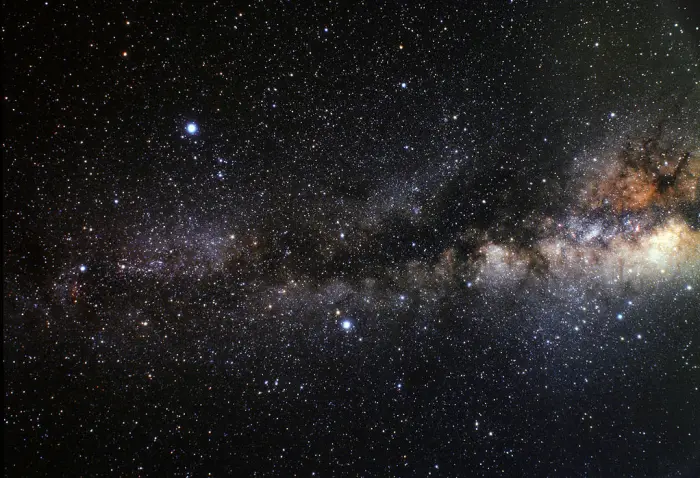
The Summer Triangle with Vega (top left), Altair (lower middle) and Deneb (far left), image: NASA, ESA. Credit: A. Fujii
Deneb is believed by some to be a member of the Cygnus OB7 association, a stellar association within the Cygnus molecular cloud complex. The vast star-forming region stretches 4 by 7 degrees across and includes the North America Nebula (NGC 7000) and the Pelican Nebula (IC 5070). The members of Cygnus OB7 lie at an average distance of 2,050 light-years. They are mostly young, hot, massive O- and B-type stars that go through their life cycle quickly due to their high mass.
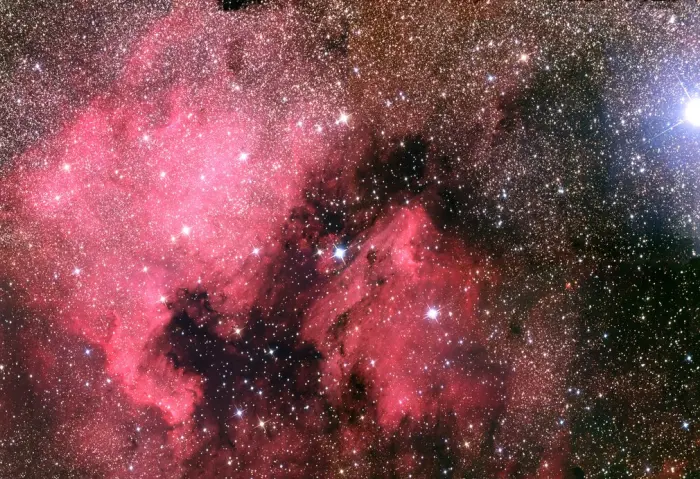
The North America Nebula (left), Pelican Nebula (centre) and Deneb (right), image credit: KPNO/NOIRLab/NSF/AURA/Adam Block (CC BY 4.0)
Deneb will be the North Pole star (the nearest visible star to the north celestial pole) around the year 9800 AD. It will only come within 7° from the pole and it will not mark true north as accurately as Polaris does.
As the pole star, Deneb will be preceded by Alderamin (Alpha Cephei) and succeeded by Fawaris (Delta Cygni). Both these stars will come within 3° of the pole. Polaris, the current North Star, is a much better indicator of true north, being located within 0.5° of the pole. However, at magnitude 1.98, it is also considerably fainter than Deneb. It is only the 48th brightest star in the sky.
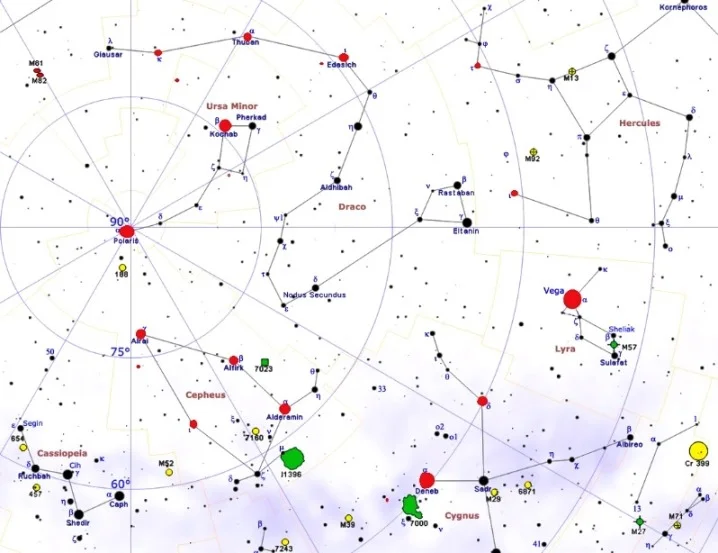
North Stars (marked red), image: Roberto Mura
Deneb is the only star in Cygnus included on the list of the 58 navigational stars. The stars selected for use in celestial navigation are some of the brightest and most recognizable stars in the sky. Vega and Altair, the other two stars of the Summer Triangle, are also members of this special group.
In the 1970s, Deneb was proposed to be a possible single-lined spectroscopic binary system with an orbital period of around 850 days. However, subsequent studies did not find any evidence to support the presence of a companion.
Like other first magnitude stars, Deneb and hypothetical planets orbiting it are often used in various works of literature, film and television, as well as in video games. Some of the best-known fictional uses of the star include Dan Simmons’ 1989 novel Hyperion, Anne McCaffrey’s The Tower and the Hive series, The Silver Surfer comic book series, the pilot episode of Star Trek: The Next Generation (“Encounter at Farpoint”) and the TV series Blake’s 7 and Babylon 5.
Name
The name Deneb is derived from the Arabic Dhanab al-Dajājah, which means “the tail of the hen.” It was officially approved by the International Astronomical Union’s (IAU) Working Group on Star Names (WGSN) for Alpha Cygni on June 30, 2016.
Three other relatively bright stars have similar official names: Deneb Algedi (Delta Capricorni), Denebola (Beta Leonis) and Aldhanab (Gamma Gruis). Deneb Algedi and Denebola mark the tails of the animals their constellations represent (the sea-goat and the lion), while Aldhanab represents the tail of Piscis Austrinus, the Southern Fish, the constellation to which it belonged in Ptolemy’s time (2nd century CE).
Additionally, the traditional (but unofficial) name Deneb el Okab, meaning “the tail of the eagle,” is shared by the stars Epsilon and Zeta Aquilae in the constellation Aquila, the Eagle. Officially named Diphda, the star Beta Ceti in the constellation Cetus, the Whale, is also known as Deneb Kaitos, “the tail of the sea monster,” while Iota Ceti is sometimes called Deneb Kaitos Shemali, or “the northern tail of the sea monster.”
Deneb has an older proper name, Arided, derived from the Arabic ar-ridf, meaning “the follower” or “the one sitting behind the rider,” possibly in reference to the other bright stars of Cygnus, which were known as al-fawāris, or “the riders.” The name has fallen out of use.
In the Alfonsine Tables, compiled in Spain in the 13th century, Deneb was listed as Denebadigege. Similar variants include Deneb Adige and Denebedigege.
The German uranographer Johann Bayer referred to the star either as Arrioph (from Al Ridf, “the hindmost”) or Gallina (Latin for “hen”).
In Chinese astronomy, Deneb was called the Fourth Star of the Celestial Ford (天津四). It formed an asterism known as Celestial Ford (天津) with Sadr (Gamma Cygni), Fawaris (Delta Cygni), 30 Cygni, Nu Cygni, Tau Cygni, Upsilon Cygni, Zeta Cygni and Aljanah (Epsilon Cygni). The asterism represented a bridge across the Milky Way. It was part of the larger Girl mansion, one of the northern mansions of the Black Tortoise.
In Chinese mythology, Deneb is associated with the myth of the cowherd and the weaver girl. In the old tale, Niu Lang (the cowherd) and Zhi Nü (the weaver girl) were lovers separated by the Milky Way. They could only meet once a year, when a flock of magpies formed a bridge.
Niu Lang was represented by the star Altair, Zhi Nü by Vega, and their two children by Tarazed (Gamma Aquilae) and Alshain (Beta Aquilae), the two stars flanking Altair. Deneb was associated with the magpie bridge or, alternatively, with a fairy who chaperoned the lovers when they met.
The meeting of the two lovers is celebrated at the annual Qixi Festival, traditionally held on the seventh day of the seventh month of the Chinese lunar calendar.
Location
Deneb is very easy to find in the sky, even in less-than-ideal conditions. The star’s brightness and the two prominent summer asterisms it forms with other bright stars – the Summer Triangle and the Northern Cross – make the supergiant easy to identify and use to find other stars and interesting deep sky objects in this region of the sky.
Deneb marks the tip of the Northern Cross and is one of the vertices of the Summer Triangle. Both asterisms are prominent and high in the evening sky throughout the summer months in the northern hemisphere. Deneb marks the top of the Northern Cross and is the brightest star in the asterism.
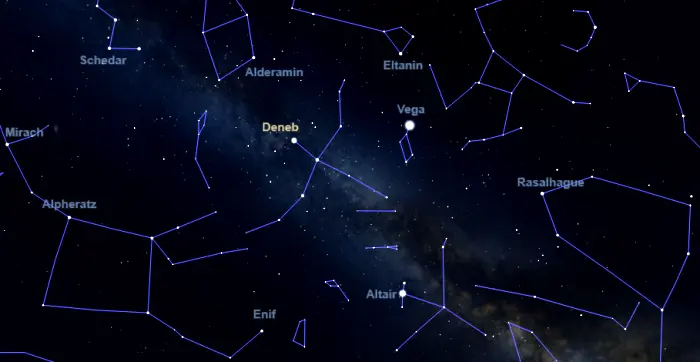
Deneb location, image: Stellarium
Deneb is visible throughout the year for observers living north of the latitude 45° N and it cannot be seen at all south of the latitude 45° S.
The North America Nebula (NGC 7000) and the Pelican Nebula (IC 5070) lie just to the east-northeast of Deneb. The two emission nebulae are part of the same H II region and are separated by a lane of interstellar dust. The North America Nebula lies approximately 2,590 light-years away and the Pelican Nebula, 1,800 light-years away.
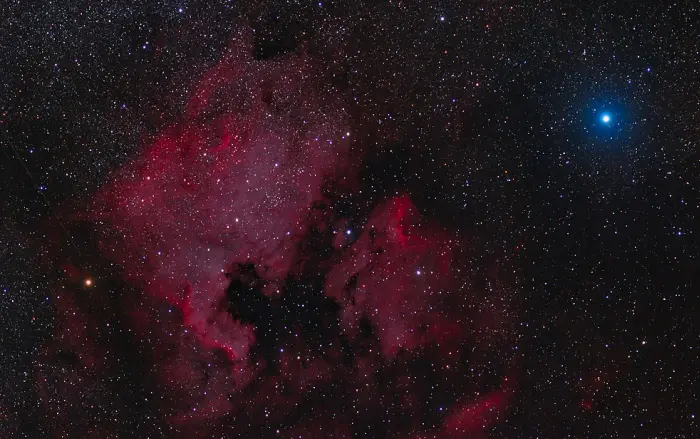
The North America Nebula and the nearby Pelican Nebula (IC 5070) are parts of the same interstellar H II region located in the Orion Arm of the Galaxy. Recent estimates of the distance to this nebula put the distance between 1800 and 2000 light years. Image credit: Giuseppe Donatiello (CC0 1.0)
Constellation
Deneb is located in the constellation Cygnus, the Swan. Cygnus is one of the most recognizable northern constellations, very easy to identify because its brightest stars form the Northern Cross. It is one of the Greek constellations, listed by the Greco-Roman astronomer Ptolemy in his Almagest in the 2nd century CE. Occupying an area of 804 square degrees, it is the 16th largest constellation in the sky.
In Greek mythology, Cygnus is associated with the myth of Zeus and Leda. In ancient lore, the god transformed himself into a swan to seduce the Spartan queen, who later gave birth to Helen (of Troy), Clytemnestra, Pollux, and Castor. The constellation was also linked with Cygnus, a close friend of Phaethon, the son of the Sun god Helios, and with Orpheus, the Greek poet and musician who was transformed into a swan and placed next to his lyre (represented by the constellation Lyra) in the sky.
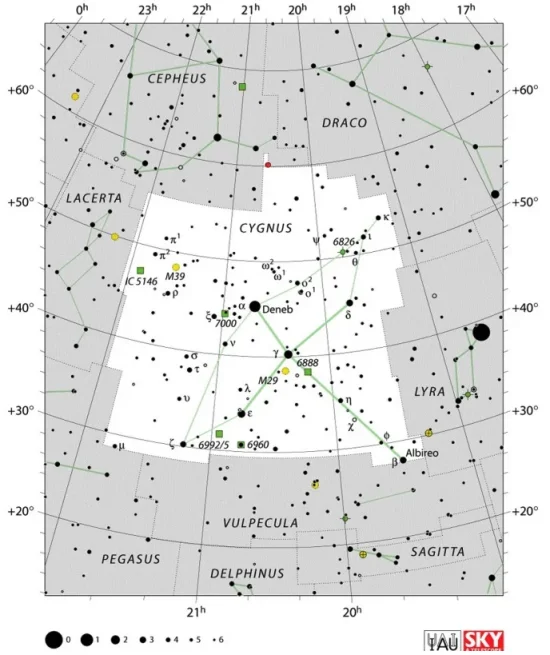
Cygnus constellation map by IAU and Sky&Telescope magazine
Cygnus is a popular target for telescopes because it is home to a number of interesting stars. These include the double stars Albireo, Fawaris and Mu Cygni, and Bessel’s Star (61 Cygni), one of the nearest star systems to Earth. Cygnus also contains the red supergiant or hypergiant NML Cygni, one of the largest stars known, and the Sun-like star Kepler-22, which hosts an exoplanet (Kepler-22b).
Notable deep sky objects in the constellation include the open clusters Messier 29, Messier 39 and NGC 6910 (the Rocking Horse Cluster), the Fireworks Galaxy (NGC 6946), and several well-known nebulae: the North America Nebula (NGC 7000), the Pelican Nebula (IC 5070), the Crescent Nebula (NGC 6888), the Gamma Cygni Nebula (IC 1318), the Veil Nebula (NGC 6960, 6962, 6979, 6992 and 6995), and the Blinking Planetary Nebula (NGC 6826).
The best time of the year to observe the stars and deep sky objects in Cygnus is during the month of September, when the constellation is high above the horizon in the evening. The entire constellation is visible from locations north of the latitude 40° S.
The 10 brightest stars in Cygnus are Deneb (Alpha Cyg, mag. 1.25), Sadr (Gamma Cyg, mag. 2.23), Aljanah (Epsilon Cyg, mag. 2.48), Fawaris (Delta Cyg, mag. 2.87), Albireo (Beta Cyg, mag. 2.90), Zeta Cygni (mag. 3.21), Xi Cygni (mag. 3.73), Tau Cygni (mag. 3.65 – 3.75), Iota2 Cygni (mag. 3.77), and Kappa Cygni (mag. 3.814).
Deneb – Alpha Cygni
| Spectral class | A2 Ia |
| Variable type | Alpha Cygni |
| U-B colour index | -0.23 |
| B-V colour index | +0.09 |
| Apparent magnitude | 1.25 (1.21 – 1.29) |
| Absolute magnitude | -8.38 |
| Distance | 2,615 ± 215 light-years (802 ± 66 parsecs) |
| Parallax | 2.31 ± 0.32 mas |
| Radial velocity | -4.5 km/s |
| Proper motion | RA: 2.01 ± 0.34 mas/yr |
| Dec.: 1.85 ± 0.27 mas/yr | |
| Mass | 19 ± 4 M☉ |
| Luminosity | 196,000 ± 32,000 L☉ |
| Radius | 203 ± 17 R☉ |
| Temperature | 8,525 ± 75 K |
| Metallicity | −0.25 dex |
| Rotational velocity | 20 ± 2 km/s |
| Surface gravity | 1.10 ± 0.05 cgs |
| Constellation | Cygnus |
| Right ascension | 20h 41m 25.91514s |
| Declination | +45° 16′ 49.2197″ |
| Names and designations | Deneb, Alpha Cygni, α Cyg, 50 Cygni, Arided, Aridif, Arrioph, Gallina, HD 197345, HR 7924, HIP 102098, SAO 49941, FK5 777, BD +44°3541, AG+45 1730, GC 28846, GCRV 12971, JP11 3264, PLX 4935.00, PPM 60323, UBV 17953, 2MASS J20412592+4516491, TYC 3574-3347-1, ADS 14172 A, CCDM J20415+4517A, IDS 20380+4455 A, WDS J20414+4517A |